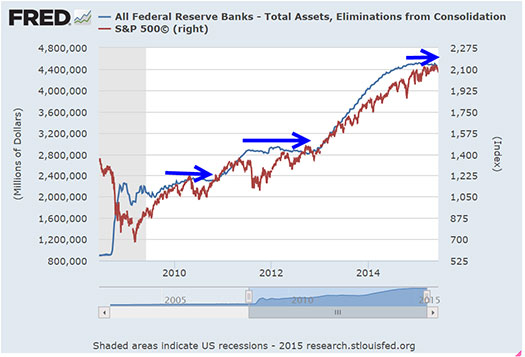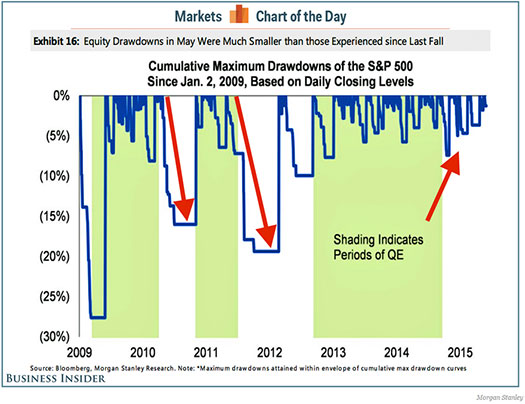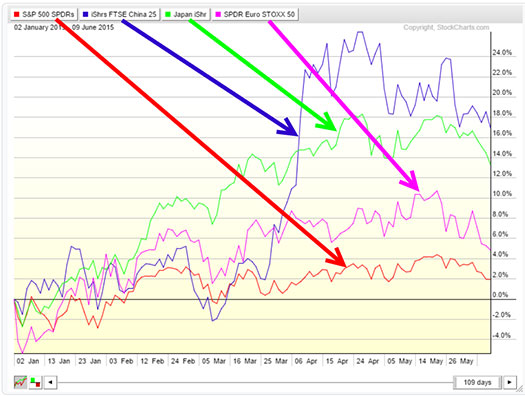Tharp's Thoughts Weekly Newsletter
-
Article: Traders and Mistakes by Van K. Tharp, Ph.D.
-
Workshops: Forex Workshop Added to September in Berlin, Germany
-
Tip: Why This QE Taper Is Different by D. R. Barton, Jr.
-
$700 Early Enrollment Discount Going On Now on
Ken Long's Day Trading Systems Workshops

Dr. Ken Long begins this workshop by teaching you two day trading systems, which he calls, the Frog and RLCO. Through his lectures you will gain an understanding of each of the systems’ interpretations of the market's movements, rules and variations.
Ken has been a long-time active trader and observer of the markets. He's noticed the consistent habit of prices for particular issues to move a certain amount. Much like a frog jumps when it hears a loud noise, prices tend to move a certain amount before they pause or move again. Different frogs are able to jump different distances, but each one tends to jump about the same distance as it did last time. Would it be possible to know about how far a stock’s price would move on any given day?
Learn how to trade these two great day trading systems, with Dr. Ken Long's expert guidance. After three action-packed days of instruction, you can opt to stay an additional two days and trade these simple-yet-profitable systems live! Students will see in real-time how these systems work in the markets, with an experienced and successful coach in the room.
Dr. Tharp considers Ken to be a rule-based discretionary trader. This week we are reprinting an article from Dr. Tharp that explores different trader types and mistakes. See if you recognize what type of trader you are.
Learn More....
To register or to see the full workshop schedule, click here.
Feature Article

Traders and Mistakes
by Van K. Tharp, Ph.D.
View on-line to resolve formatting problems
I’ve always said that trading is mostly psychological and that traders should spend a lot of time working on their core issues. In fact, most of my Super Traders spend at least a year working on psychological issues before they get to work on their business plan or trading systems. One area where psychological issues can appear in trading is in mistakes.
So let’s look at the psychology of trading from the angle of mistakes. When you don’t follow your rules, you make a mistake. It’s that simple. And making the same mistake repeatedly is called self-sabotage. Self sabotage is another area of psychology rich with the opportunity for understanding yourself to improve your trading results. Here, however, we’ll focus on mistakes relating to some broad categories of traders.
First, let me introduce one way to measure mistakes' impact on your trading. Trader efficiency is a measure of how effective a trader is in making mistake free trades. So a person who makes five mistakes in 100 trades is 95% efficient. In the last five years I’ve requested that my Super Traders document their mistakes so that we can look at their efficiency levels. I have found that 95% is actually a very good trading efficiency level; many traders can’t even trade at 75% efficiency—which is terrible. That’s one mistake in about every four trades. This is most important for one category of traders: rule-based discretionary traders.
In my opinion, when rule-based discretionary traders become efficient, they are by far the best type of trader.
There are two other groups of traders I’d like to talk about first; 1) mechanical traders and 2) no-rule discretionary traders.
Mechanical Traders
First, we’ll look at mechanical traders. Mechanical traders believe that they can eliminate psychologically related trading problems by becoming mechanical. Many people aspire to be mechanical traders, letting a computer make all the decisions for them, because they believe it factors out many human-based errors.
In fact, one of my best trader friends said to me once that psychology didn’t enter into his trading because his operation was totally automated. My response was “You could decide not to take a trade.” About 18 years after I made that statement, his CTA business closed down. His partner decided against taking one trade—the trade that would have made their entire year had they taken it.
I’ve always said that people can only trade their beliefs about the market, so let’s look at some of the most important beliefs that a pure mechanical trader might have:
| |
• |
With mechanical trading, I can be objective and not make mistakes (except the psychological mistake of overriding my system). |
| |
• |
Mechanical trading is objective. My system testing will allow me to determine my future results. |
| |
• |
Mechanical trading is accurate. |
| |
• |
If a system’s underlying logic cannot be turned into a mechanical trading system, it probably isn’t worth trading. |
| |
• |
Human judgment is too prone to errors. I can eliminate those through mechanical trading. |
So then, is mechanical trading truly objective? I tend to think not because there are all sorts of errors that can creep into an automated trading system: data errors, errors in the software platform, errors in your own programming, and many more. (Interestingly, one of the main categories of errors that my Super Traders come up with consistently is programming errors.)
Let’s consider data errors. Is your data accurate or does it have bad ticks and other issues with it? Mechanical traders are always dealing with data errors of some sort. For example, price errors can show up in streaming data quite regularly. Sometimes those are resolved within seconds and the error “disappears” but, by that point, the bad data may have triggered a trade already. Additionally, historical stock data may or may not have dividend and split adjustments. And what happens when a company goes bankrupt? What if it goes private or is bought out by another company? Those companies’ data may simply disappear from your data set.
I once wanted to research an efficient stock trading system. We looked for efficient stocks (moving up without much noise) and bought them with a 25% trailing stop. We had an S&P 500 data set going back 40 years that was supposed to be clean and adjusted for splits and dividends. I was very pleased with the results because my system made a small fortune. I didn’t realize this at the time, however, but the system traded on “inside information.” Because of the data set, I was able to buy stocks at the IPO that would later become part of the S&P 500. Thus, my system, in back test, bought Microsoft, EBay, Intel, and many other companies before anyone knew they would become part of the S&P 500. Why? Because, as I said, my data set was today’s S&P 500 going back 40 years.
And what about Thursday May 6th, 2010 when we saw a mini-crash? The Dow Jones dropped 1,000 points in the space of about 20 minutes. Blue chip stocks like Procter & Gamble dropped over 20 points, and Accenture even went to a penny per share briefly. While there may not have been one root cause for that mini-crash, it had a major effect on mechanical trading systems. Things like that happen in the markets; such are the challenges (error/mistakes) for mechanical systems. (That afternoon’s swing affected lots of regular traders, too. One client said he used 25% trailing stops on all of his positions and got stopped out of every single stock.)
Meanwhile, one of our instructors, Ken Long, trades rule-based discretionary systems and made 100R in that same week. As always, he was very conservative in his trading and very careful to make sure that he fully managed his risk.
There is another class of error that is made by mechanical trading systems: the error of omission. Because the criteria by which trade setups and entries are so precisely defined, mechanical systems miss many good (or great) trades that a discretionary trader would spot easily.
For example, suppose your systems screens for five consecutive lower closes. After you get five consecutive lower closes you then look for an inside day. Now you have your full setup. Your entry is a few cents above yesterday’s high.
So let’s look at some examples of other entry signals you might miss by being so precise. You could have four down days that were extreme—perhaps the price is down 30%. Or you could have less than four down days that where the price is 30% lower or more. However, neither of those example would be an adequate down move according to your strict mechanical criteria.
Let’s say you found something that had five days of new lower lows but the fifth down day might open on a new low and then close on a new high. That’s usually an extremely bullish signal, but you’d miss it by your precise definition. Or, you could have five days of lower closes and the sixth day opens on a new low but closes on a new high. Thus, the precise entry definition would miss a trade opportunity with even more weakness followed by an extreme bullish signal.
There are a lot more variations of this entry that a mechanical system would miss, but you get the point. As soon as you state your rules so precisely that a computer can execute the trades, you open yourself to errors of omission—good or outstanding trades that your automated system cannot take because of its precision. Those missed opportunities don’t qualify as mistakes but they severely limit the potential results of the underlying logic behind the system. The mechanical system results will look rather weak next to the results of a trader who used that same system and was allowed some discretion to take the all of those other trades that didn’t quite fit the precise mechanical system rules.
No-Rules Discretionary Traders
In my experience, when most people say “I am a discretionary trader,” it basically means that they are free to do whatever they want. They can take a newsletter recommendation, trade a high probability setup based on what some guru said in a workshop last year, or perhaps just buy something on a whim. They might feel they have 20 different systems with none of them rigid.
In reality, they have no systems at all. What they really have is a little bit of nothing and a lot of “into-wishing” (as opposed to intuition). As a result of having no system and no rules, they have no way of effectively managing their trading. How well do you think a company would operate with no plans, no business systems and no rules? Because they have no rules to follow, everything no-rules discretionary traders do is a mistake.
Now in fairness, some of discretionary traders have rules for at least a portion of their trading. There’s hope for these people because they have a starting point. Those who are totally no-rules discretionary traders, however, have no hope and should either stop trading or totally revamp their trading business.
Are you a discretionary trader? How would you be able to tell? Here is a quiz that will help you decide. Answer Yes or No to the following questions.
| 1. |
|
Do you sometimes buy newsletter recommendations without having a real plan for how you’ll get out of the trade? |
| 2. |
|
Do you occasionally (or often) take trades based upon some interesting indicator that you learned in a workshop (i.e., when you see that indicator go, you usually get into a trade, but again you have no real plan about how you’ll get out of the trade)? |
| 3. |
|
Do you trade three or more different systems in the same account? |
| 4. |
|
Do you trade more than ten different systems? |
| 5. |
|
Do you sometimes enter a trade and later not remember why? |
| 6. |
|
Are you unsure of how many systems you have? |
| 7. |
|
Do most of your systems lack a complete set of rules to guide your behavior? |
| 8. |
|
Are your systems equivalent to the setups used to get into the trades and nothing more? |
| 9. |
|
Are you unable to list the rules for the last trade you made? |
| 10. |
|
Are you unable to list the rules for any of the last five trades you made? |
If you answered Yes to as many as two of the questions above, you have some elements of a no-rules discretionary trader. However, if you answered Yes to 6 or more questions above, you definitely are a no-rules discretionary trader.
Chances are you seldom make money in the market because you are not playing a winning game. You probably make many mistakes. In fact, since you don’t have rules, I would consider everything you do to be a mistake until you have a set of rules in place. How can you effectively learn from any of your trading experiences if you do not know which ones are mistakes?
If it is any consolation, most traders fall into the no-rules discretionary category. The best among this group might be dedicated to following the trades of a single newsletter. If that applies to you, do you even know the rules of the newsletter? Does the newsletter writer have rules to guide his trading? Chances are, if he must come out with a specific recommendation once every month on a specific date, he doesn’t have such rules. And chances are also good that you don’t follow the recommendations of the newsletter writer exactly: you don’t take some trades, you may miss some others, you buy at a price other than that recommended, and you probably don’t sell when you are told to. Again, these are all signs of a no-rules discretionary trader.
Rule-Based Discretionary Traders
Chances are you’ve never heard of a rule-based discretionary trader. They are rare, but they are among the best traders in the world. I can safely say that anyone who graduates from my Super Trader program has become either a rule-based discretionary trader or a mechanical trader.
Here are some rules that such a trader might have:
| |
• |
Look at a small universe of stocks that behave well according to my rules. (In other words, not every stock has to behave according to your rules; you just find stocks that do). |
| |
• |
Look for a strong overreaction to the downside. (This would have a very specific description—e.g., market closes down for six straight days). |
| |
• |
Look for moves with a high probability for a continuation in my favor. (This might be one or several rules that are clearly specified). |
| |
• |
Have a likely target in mind based on a prior swing high so that the difference between the entry price and the high is my likely target. |
| |
• |
Place a stop below the most recent low of the last down day so that the difference between that low and the entry price is the risk of the trade. |
| |
• |
Make sure that the reward-to-risk ratio of any trade is at least 3 to 1. If it’s not, look for another trade. |
| |
• |
Raise the stop when the market makes a new level of support and rises to a new high. Make sure that the ongoing reward to risk in the trade is always above 1 to 1 to allow for profits bigger than 3R. |
| |
• |
Never have more than four active positions at a time so that every trade can be carefully managed. |
| |
• |
Never risk more than 0.5% of equity per position. |
| |
• |
Never have more than 1% open risk in my account at any given time. |
| |
• |
Evaluate my mistakes each evening and work to make my trading efficiency 95% or better. |
| |
• |
Re-evaluate my rules if I’m not up by at least 5R at the end of the month. |
Notice how every aspect of trading is covered by these rules. They allow for some discretion (i.e., what constitutes a 3 to 1 reward-to-risk trade and the ability to stay in the trade after it reaches your target), but at the same time there are clear guidelines for the trade. In addition, the trader could add a few other discretionary rules to improve his/her performance:
| |
• |
I can re-enter the trade once if the reward-to-risk potential is still at least 3 to 1. |
| |
• |
I can add a second position to the trade the first time I raise my stop if the new reward-to-risk ratio is at least 5 to 1.
|
| |
• |
If something really bothers me about the trade and I can document it, I don’t take it. |
The rules I’ve given are just examples. I’m not even saying that they are profitable rules, although I’ve seen similar rule sets that are exceptionally good.
At the end of the day, this trader can do a daily debriefing and ask, “Did I make any mistakes? Did I follow my rules?” Based on his answers to those questions, he can 1) record any mistakes, 2) assess the impact of the mistakes in terms of R-multiples, and 3) take corrective steps to avoid those mistakes in the future. These tasks are critical to developing strong, consistent performance. Can you see how these steps are impossible for the no-rules discretionary trader?
Editors note: Today's article ran previously as a three-part series in Tharp's Thoughts.
About the Author: Trading coach and author Van K. Tharp, Ph.D. is widely recognized for his best-selling books and outstanding Peak Performance Home Study Program—a highly regarded classic that is suitable for all levels of traders and investors. You can learn more about Van Tharp at www.vantharp.com. His new book, Trading Beyond The Matrix, is available now at matrix.vantharp.com.
Update to the Super Trader Program
Recently, Dr. Tharp announced a price increase coming soon for the Super Trader Program. And, you still have time to apply and be accepted into the program at the current rates!
There are two opportunities to attend qualifying workshops in order to be considered for the program before the price increase takes effect. One is the Oneness Awakening Workshop in just a few weeks and the other is Peak 101 in August.
Click here to read more and see the deadline for the old prices...
Workshops
Combo Discounts available for all back-to-back workshops!
See our workshop page for details.
Trading Tip

Why This QE Taper Is Different
by D. R. Barton, Jr.
View on-line to resolve formatting problems
Massive central bank quantitative easing (QE) HAS inflated assets prices, including equities market, and specifically, U.S. equity markets.
There. I said it. Just so you know where I stand.
Many people have tried to look at the chart below showing the Fed’s balance sheet and the stock market boom and tried to explain it away with the phrase “correlation doesn’t equal causation.” While I generally agree with that idiom, sometimes things are pretty clear. When you put heat to the tea kettle, water boils. And when you massively infuse money into the system, prices of financial assets rise. Not forever, but they do go up.
Let’s look at that infamous chart comparing the Fed Reserve’s total assets to the price of the S&P:

The blue arrows show the periods at the end of specific QE programs – and those times are clearly periods when the markets struggled. In fact, at the end of “QE1” and “QE2” the market had very meaningful pullbacks. But at the end of QE3-4 (there was not pause between them), pullbacks (so far!) have been quite modest. Here’s a chart from Morgan Stanley as reported by Business Insider that illustrates this point quite well:

What’s Different This Time?
While the U.S. Fed is not currently in a QE period, other central banks are just getting ramped up. Most notably, the European Central Bank, the People’s Bank of China and the Bank of Japan all have their collective feet to the QE accelerator. And just in case there are those out there who still doubt the “QE to equity price correlation,” let’s put all that to rest with one final chart showing the broad equities index associated with the central bank that stopped QE last year (the U.S.) and the indexes aligned with the three central banks that continue on with QE (Europe, Japan and China):

Click Here For a Larger Image
For sure, other influences come into play, especially in the short term. But there is really no denying that the elephant in the room, equities-wise, is central bank monetary policy. How else does one explain why the U.S. monthly employment report last Friday, that was broadly seen as very strong, sent stocks down? The reason is that traders and investors interpreted that news as leading to a Fed interest rate increase that accelerated into the second half of 2015 instead of putting said rate hike off until 2016.
Until every scrap of financial news is no longer parsed-in relative to how that news will affect global and/or regional QE programs, the “central bank as financial saviors” narrative will continue to be the single dominant market mover.
Your views and comments are always welcome - please send them to drbarton “at” vantharp.com — I always enjoy hearing from you!
Great Trading,
D. R.
About the Author: A passion for the systematic approach to the markets and lifelong love of teaching and learning have propelled D.R. Barton, Jr. to the top of the investment and trading arena. He is a regularly featured analyst on Fox Business’ Varney & Co. TV show (catch him most Thursdays between 12:30 and 12:45), on Bloomberg Radio Taking Stock and MarketWatch’s Money Life Show. He is also a frequent guest analyst on CNBC’s Closing Bell, WTOP News Radio in Washington, D.C., and has been a guest on China Central Television — America and Canada’s Business News Network. His articles have appeared on SmartMoney.com MarketWatch.com and Financial Advisor magazine. You may contact D.R. at "drbarton" at "vantharp.com".
Matrix Contest
 Enter the Matrix Contest Enter the Matrix Contest
for a chance to win a free workshop!
We want to hear about the one most profound insight that you got from reading Van's new book, Trading Beyond the Matrix, and how it has impacted your life. If you would like to enter, send an email to [email protected].
If you haven't purchased Trading Beyond the Matrix yet, click here.
For more information about the contest, click here.
Ask Van...
Everything we do here at the Van Tharp Institute is focused on helping you improve as a trader and investor. Consequently, we love to get your feedback, both positive and negative!
Send comments or ask Van a question by clicking here.
Also, Click here to take our quick, 6-question survey.
Back to Top
Contact Us
Email us at [email protected]
The Van Tharp Institute does not support spamming in any way, shape or form. This is a subscription based newsletter.
To change your e-mail Address, e-mail us at [email protected].
To stop your subscription, click on the "unsubscribe" link at the bottom left—hand corner of this email.
How are we doing? Give us your feedback! Click here to take our quick survey.
Call us at: 800-385-4486 * 919-466-0043 * Fax 919-466-0408
SQN® and the System Quality Number® are registered trademarks of the Van Tharp Institute and the International Institute of Trading Mastery, Inc.
Be sure to check us out on Facebook and Twitter!
 
Back to Top |
|
June 10, 2015 #737

Our Mission
Van's Top-Twelve Favorite Trading Books
Van's Favorite Non-Trading Books
Viewing on-line eliminates spacing, and formatting problems that may be unique to your email program.

Ongoing Contest: Learn how you could win a $50 coupon and a grand prize of a free workshop!

"I base my long-term, monthly rebalancing [core] strategies on research into relative strength and momentum as it relates to broad asset classes."-K Long

A Must Read for All Traders
Super Trader
How are we doing?
Give us your feedback!
Click here to take our quick survey.
From our reader survey...
"I think the newsletter is extremely generous and it is a resource I utilize constantly. I have saved every single one since I first subscribed."
Trouble viewing this issue?
View Online. »
Van Tharp You Tube Channel
Tharp Concepts Explained...
-
Trading Psychology
-
System Development
-
Risk and R—Multiples
-
Position Sizing
-
Expectancy
-
Business Planning
Learn the concepts...
Read what Van says about the mission of his training institute.
The Position Sizing Game Version 4.0
Have you figured out yet how to pick the right stocks? Are you still looking for a high win-rate trading system? When you’re ready to get serious about your trader education, download the Position Sizing Game to learn some true fundamentals of trading success. Learn more.
To Download for Free or Upgrade Click Here

Download the first three levels of Version 4.0 for free:
Register now. »
Trouble viewing this issue?
View Online. »

Dr. Tharp is on Facebook

Follow Van through
Twitter »

Check out our home study materials, e-learning courses, and best-selling books.
Click here for products and pricing
What Kind of Trader Are You? Click below to take the test.
Tharp Trader Test
Back to Top

Introduction to Position Sizing™ Strategies
E-Learning Course
Perfect for auditory/visual learners who learn more effectively from an instructional format that is full of interactive features!
Only $149
Learn More
Buy Now
SQN® and the System Quality Number® are registered trademarks of the Van Tharp Institute
|